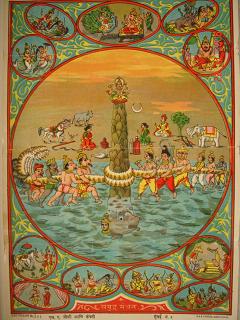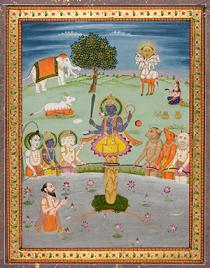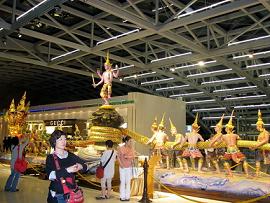The famous Indian story of Amrit Manthan or Samudra Manthan – which is considered as one of the important Hindu legends of evolution – has been immortalized in all oriental cultures through paintings and sculptures in museums and heritage sites across India and many countries like Cambodia and Thailand….The world’s biggest gatherings of human beings at Kumbh Melas held in Haridwar, Ujjain, Nashik and Prayag are also associated with this fabulous legend, which is central to Hindu culture…
Last year (2010-11), when the gigantic Kumbha Mela was organized on the banks of the Ganga in Haridwar, the whole world sat up and took notice of the record crowds of Indians from all regions and a huge number of international visitors who arrived in this holy city in the Himalayas. Figures quoted by various sources put the number at 30 to 40 million which, by all accounts, seem almost fictional. Whatever the real number, it was undoubtedly humongous! Yet, the law and order authorities in India as well as millions of visitors and TV watchers and Facebook aficionados around the world wondered at the absolute discipline and order with which the Mela was organized from January 14 to April 28. Acknowledged as the largest religious gathering in the world, this event happened when the planet Jupiter entered Aquarius in January and the Sun entered Aries in April. In this huge gathering, there were sadhus from hundreds of orders of sanyasis, foreign tourists from the U.S., U.K., Europe, Russia and millions of devotees from all corners of the sub-continent. All of them converged on the banks of the Ganga to have their ritual bath in the sacred river during the Kumbh Mela.
Held once in 12 years at one of the four designated holy cities in India, the Kumbh Mela has been described also as the world’s largest congregation of humanity. The other three cities are Ujjain on the banks of the River Kshipra, Madhya Pradesh, Nashik on the banks of River Godavari in Maharashtra and Prayag at the confluence of the Rivers Ganga, Yamuna and Saraswati in Uttar Pradesh. This is where the next Maha Kumbh will be held in 2012-13 at a projected cost of Rs.753 crores! The Kumbh Mela has also been described as the ‘Festival of the Pot of Nectar which symbolizes immortality’ and filmed or videoed by innumerable visitors. Many of these videos can be seen on the Internet.
The first written evidence of the Kumbh Mela held as an event, is found in the accounts of the well-known Chinese traveller and writer, Huan Tsang or Xuanzang (602 - 664 A.D.) who visited India from 629 to 645 CE, during the reign of the King Harshavardhana. Harshwardhana was a powerful emperor who ruled for forty one years, with his empire including Punjab, Rajasthan, Gujarat, Bengal, Orissa and the whole of the Indo Gangetic plain above the River Narmada. It is believed that ever since then; the Kumbh Mela has regularly been celebrated in India for centuries. However, it is fascinating to know the story of this event in yet another context.
In Indian culture, the origin of this wonderful Pot of Nectar is found in one of the most celebrated and venerated fables of creation and evolution: The Samudra Manthan episode (Churning of Kshirsagar or the ocean of milk), which is described in the Bhagavata Purana, Vishnu Purana, the Mahabharata and the Ramayana as well as many other religious texts.
The story says that the gods lost their strength due to the curse of the Sage Durvasa who was annoyed with them because Indra, the king of the heavens had offended him. To regain it, they thought of churning the Kshirasagar or the cosmic ocean of milk, to obtain the nectar of immortality or Amrit. This project needed that they make an understanding with their enemies, the Asuras or demons, to work together and to share the nectar. However, when the pot appeared from the ocean with Dhanvantari, the divine doctor carrying it, a fight ensued. For twelve days and nights, the gods and demons fought for the pot of nectar. It is believed that Lord Vishnu took the pot and taking the form of Mohini, a beautiful woman, promised to serve it to all the Gods who sat in a line to receive their share. However, two demons suspected this move and taking the form of Gods, they also joined the line. The Sun God recognized them and chased them away. Rahu and Ketu pursued him and it is said that whenever they catch him, there is a solar eclipse. While all this was happening, from the pot in the hands of Vishnu, drops of nectar fell at four places on earth: Prayag, Haridwar, Ujjain and Nashik, and that is where the Kumbh Mela is observed every twelve years. These are the national celebration of the Amrit Kumbh or pot of nectar which gifts immortality.
What is interesting is how the Samudra Manthan or churning of the ocean was conducted and how finally, nectar was found. The fable says that the Mandara Mountain was used as the churning rod and the snake Anant was the rope for the rod. The gods on one side and demons on the other side held one end each of the snake and continued to churn the ocean for days. To steady the churning rod, Vishnu took the form of a turtle or tortoise on whose back the rod rested in the sea bed.
The fable says that 14 jewels or Ratnas were obtained from the ocean. These are: 1.Kamadhenu or Kapila the cow, 2. Airawat, the elephant, 3. Uchaisravas, the divine horse; 4. Gada, the mace, 5. Varuni or Sura, the wine; 6. Kaustubha, the gem; 7. Lakshmi, the goddess of wealth and splendour; 8. Chandra, the moon; 9. Apsaras, the celestial nymphs and dancers; 10. Parijat, the celestial flowering tree; 11. Panchajanya Shankha, the sacred conch; 12. Sharanga, the bow, 13 Kalpavriksha, the tree which grants all wishes and finally, 14. Dhanvantari, the physician of the gods with the pot of nectar. However, after these were extracted, Halahala or poison was left and no one was prepared to take it. Lord Shiva, to save the universe, swallowed it and was given the name of Neelkanth or the blue-throated god because of this. He put the moon over his head to cool it and also had the Ganga descend into his hair to cure of the effect of the poison. The rest of the jewels were distributed among the various gods with Vishnu and Indra getting the most. It must be noted that various sources give different lists of these jewels.
This story, one of the basic Indian theories of evolution, has influenced all oriental cultures in a major way. In India, Cambodia, Thailand and Sri Lanka, many paintings and sculptures show this millennia-old influence. The worship or celebration of the pot of nectar is seen in all Indian rituals and sacraments like weddings, house-warmings, havans, festivals and celebrations. The desire for immortality and full pot or kalash which symbolizes it has spawned great art, music and dance in Indian culture.
The author was Editor of Femina for 25 years. Vimla Patil is among India's senior most Journalists-Media persons. She excels in writing lifestyle pieces, women's concerns, travelogues, celebrity interviews, art-culture pieces about India. Visit her site www.vimlapatil.com
Also see pictures:
•Kumbh Mela 2010
•Kumbh Mela Prayag 2001
• Samundra Manthan at Bangkok Airport (pic no 32-35)

Samudra Manthan 19th century lithograph |

Samudra Manthan Ball State University, a Midwestern university located in Muncie, Indiana, |

Samudra Manthan in Angkor Vat |

Samudramanthan at Suvearnabhumi airport Bangkok |